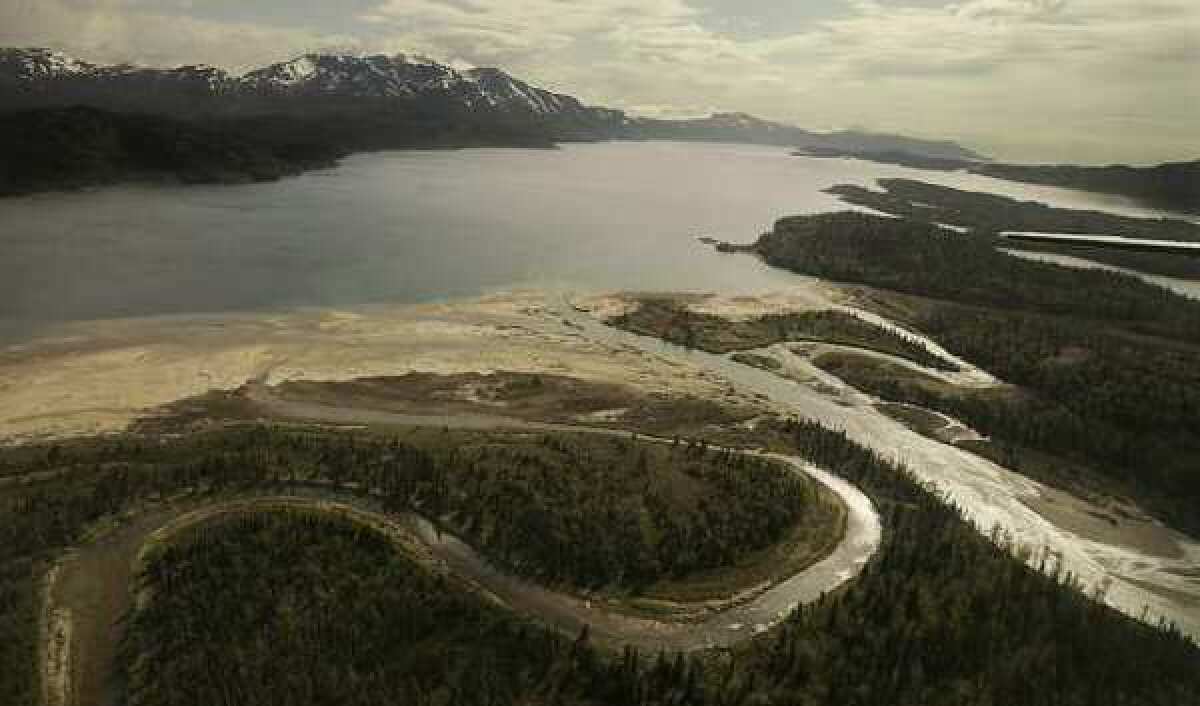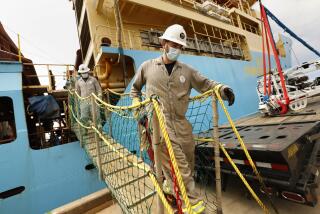Pebble mine could devastate Alaska rivers, streams, EPA says

- Share via
SEATTLE -- The Environmental Protection Agency is warning that plans for a massive mine in the hills above Bristol Bay in Alaska — home of the biggest sockeye salmon fishery in the world — could have devastating consequences for rivers and streams and wipe out habitat for fish.
A study that represents the federal government’s first significant scientific assessment of the proposed Pebble mine site concludes that extracting billions of pounds of gold, copper and molybdenum from the region could result in the direct loss of up to 87 miles of streams and nearly seven square miles of wetlands.
“We conclude that, at a minimum, mining at this scale would cause the loss of spawning and rearing habitat for multiple species of anadromous and resident fish,” according to the EPA watershed assessment released Friday. And that’s even without the failure of one of the massive tailings dams the agency said could be as high as the Washington Monument.
In that case, agency scientists said, more than 30 miles of salmon-bearing streams would be destroyed, and others would have “greatly degraded habitat” for decades.
The EPA’s assessment, even before its release, has touched off a political firestorm, with Alaska’s Republican administration warning that the agency has no authority to conduct the assessment.
In an extraordinary measure, U.S. Rep. Darrell Issa (R-Vista), chairman of the House Committee on Oversight and Government Reform, also raised questions about the EPA’s authority to regulate the proposed mine and issued a demand for the entire range of documents, sources and communications the agency used in preparing its findings.
The demand, contained in a May 10 letter to EPA Administrator Lisa P. Jackson, calls for the agency to reveal the names of all employees who had communications with Bristol Bay residents, fishermen and tribesmen who petitioned for the agency’s watershed review; the names of individuals who organized Jackson’s site visit to Bristol Bay; and all internal documents and communications related to the agency’s determination of whether it has jurisdiction over permitting for the mine.
The query makes it clear there will be a tough political fight over the mine, not only in the Obama administration, but in Congress, where Republicans have long been gunning for the EPA.
The main controversy at the moment surrounds the question of which federal agency has chief jurisdiction over granting a permit for the mine. The U.S. Army Corps of Engineers by law issues dredging and filling permits for mines, and generally is inclined to approve them. But EPA regulations under the Clean Water Act give the agency the authority — hotly disputed — to veto discharges of dredged or fill material if it would adversely impact municipal water supplies, shellfish beds or fisheries.
The regulation says the agency can issue the veto even in cases — such as the Pebble mine area — where no permit has been applied for.
Presumably, the watershed assessment could be a first step in making such a determination, one reason the Alaska attorney general, U.S. Sen. Lisa Murkowski (R-Alaska) and others have questioned the EPA about preparing it.
“I remain concerned that an attempt to preemptively veto the Pebble mine would have the practical effect of halting any development in the Bristol Bay area that might generate dredge or fill material,” Murkowski wrote in a recent letter. “It remains unclear to me how dredge or fill material from a mining operation might be substantively different from dredge or fill material generated from any other form of development.”
Meanwhile, U.S. Sen. Maria Cantwell (D-Wash.), whose district includes many of the biggest fishing companies that operate in Bristol Bay, has supported the agency’s work.
“The watershed assessment released today is an important step towards protecting wild Bristol Bay salmon and the thousands of Washington state jobs that rely on them,” Cantwell said in a statement. “This draft report validates the concerns of the Alaska and Washington fishing fleets that the proposed Pebble mine could have devastating impacts to the Pacific Northwest’s maritime economy.”
The Pebble Limited Partnership, a consortium of developers of the proposed mine, said it has budgeted $107 million to conduct further studies and prepare a permit application for the proposed mine, whose true scope cannot be known until the application is submitted.
EPA officials emphasized that they were relying in their assessment on estimates of what might occur based on known mineral deposits in the region. The amount of ore processed could range between 2 billion and 6.5 billion metric tons, the agency said, calling for a mine pit and tailings impoundments that could spread over an area of up to 16.8 square miles.
Agency officials said they had made no decision about what action, if any, the EPA would take on any mine permit proposed.
“EPA’s focus in the assessment is scientific and technical; the agency has made no judgments about the use of its regulatory authority under the Clean Water Act, and the draft study in no way prejudges future consideration of proposed mining activities,” the agency said in a statement.
Opponents of the mine said the watershed assessment, which is only a draft and will now be presented at public hearings for comment through July 23, is a good first step.
“This document gave us some historical and scientific perspective upon which to make decisions,” Tim Bristol of Trout Unlimited in Alaska, a group that has raised concerns about the proposed mine’s impacts on fishing, told the Los Angeles Times.
“Until now, no one in Alaska has been willing to listen to people in Bristol Bay about what they want,” he said. “The governor has turned a deaf ear. The attorney general has been outright hostile. No one has listened to the tribes or the fishing industry, and it’s gratifying that somebody is taking seriously the responsibility to protect those resources.”
Still, there has been substantial support, in Alaska and in some quarters elsewhere across the country, for the mine and the jobs and tax revenues such an enormous project might bring.
“When it comes to critical metals and minerals, the U.S. is heavily dependent on foreign sources of supply,” Daniel McGroarty, president of American Resources Policy Network, said in a statement. “The EPA’s actions will have a chilling effect on domestic resource development, which will impact our national security, manufacturing competitiveness and ability to innovate.”
ALSO:
Trayvon Martin and George Zimmerman: A portrait of The Retreat
Home of the Braves no more: Oregon bans Native American mascots
Woman who sent adopted boy back to Russia must pay $1,000 a month
More to Read
Sign up for Essential California
The most important California stories and recommendations in your inbox every morning.
You may occasionally receive promotional content from the Los Angeles Times.









